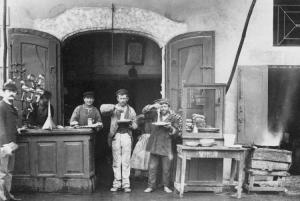You’re used to eating pasta with a fork, but the people of Naples – a place with a long tradition of pasta production have a unique way of eating that is far different than you can imagine.
Pasta has long become a familiar dish not only of local people but also of many people around the world.
However, many people still do not know the heroic history of this dish as well as the traditional way to eat pasta.
If you have the opportunity to go back in history to the 19th century, every time you go out in the city of Naples, you will feel the richness of the cuisine here, especially the pasta.
On the street, street vendors send people to attract the attention of diners, while the chef will dip long bundles of spaghetti into a pot of boiling water.

Two men carry plates of spaghetti next to a street vendor.
Pasta dishes will be served to customers who need it. After being served, these people – nicknamed “Pasta eaters” in Naples – will use their hands to pick up large pieces of noodles and put them in their mouths.
Few people know, since the 17th and 18th centuries – “Pasta” – a street food – has been used as a general term for all kinds of noodles. And like any street food, Pasta was not eaten with a fork (fork) as it is now, but with bare hands.

A Pasta restaurant on the street in Naples, Italy.
This custom is one of the things that attracts visitors to Naples. Images of people eating pasta are stored in travel guides, painted on pictures and then even photographed and recorded in film or postcards.
Some pasta vendors even instruct tourists to try this style.
Holding a handful of pasta in your mouth with just one bite is like a sport, or a culinary challenge.
In a book published in 1832, Andrea de Jorio, an anthropological cleric, described how to eat pasta “Neapolitan style” – that is, to be “swallowed definitively in one sitting”. .
De Jorio then further explained that : “to complete this challenge, the noodles from the upper hand must be connected to the throat without being bitten off anywhere” . And obviously, diners find this to be a very stimulating entertainment.

People eating pasta, photographed by Giorgio Sommer in 1873.
Many visitors see this type of eating as an interesting performance. Some people even threw a few coins to lazzaroni – beggars on the roadside to admire an artful maddening of spaghetti.
While driving through the market in Naples, John Lawson Stoddard – an American tourist bought 20 plates full of pasta just to watch others eat.
“That moment is when one person holds a plate of spaghetti, a dozen others jump in, pick up the steaming noodles and swallow the mixture down their throats. The excitement for this popular dish is proof of the hunger of the poor here”.
As Stoddard realized, pasta was not just a Neapolitan custom, it was something that fed the poor.
Spaghetti was first brought to Sicily by Arab merchants around the 12th century. It was not until 300 years later that this dish reached the people of Naples.
In the mid-14th century, Italians used a fork to eat pasta. For centuries, only the rich could eat pasta on special occasions. As for poor farmers, this dish is like a rare privilege that can only be tasted once in a lifetime. That all changed when in the 17th century, pasta became a street food.

Two children devouring spaghetti, photographed in 1900.
In the 17th century, the price of meat and vegetables suddenly increased while the price of bread and pasta fell steadily. At that time, people had new technologies in kneading and pressing flour that made the production of pasta easier than ever.
Naples, with its excellent ingredients and a sea climate suitable for drying noodles, has become the center of pasta processing and enjoyment.
Poor Neapolitans, who used to eat only cabbage and meat, are now completely addicted to pasta, which can fill an empty stomach and is rich in calories. The Neapolitans then took on the nickname “pasta-eaters” , a nickname that had only ever been reserved for the Sicilian people.
When the great poet Goethe visited Naples in 1787, he found that instant pasta could be bought anywhere for a very cheap price. These shops quadrupled in the 18th century, popping up everywhere on the streets and in markets.
Fresh pasta, made from durum wheat, often exposed to the sun and cool coastal air, sprawls on drying racks near the stalls.
Spaghetti is boiled in a large charcoal pot. Noodle broth is often added with a little salt and lard. Also, hard cheese was the only condiment before ketchup was added to pasta in the 19th century.

Pasta Makers, photo by Giorgio Sommer.
While most of the pastas in Naples are reputed to be the best in Italy, the stuff sold to the poor is not.
A large portion of pasta eaters can only afford poor quality, dusty, and sour-tasting pasta. Stoddard describes “dirty men hanging strips of flour on a drying rack amid the dust, rubbish and ruins of the streets of Naples”.
Stoddard mentioned in his book that a friend of his was “so sick that he almost threw up the pasta he ate the night before, and has never touched it since”.
In the 20th century, Naples’ dominance in the pasta industry was gradually waning. In an effort to make Italy self-sufficient, Mussolini moved durum farming from the south to the center and north of the country.
Later, factories in the North made spaghetti and dried it using electric ovens instead of sunlight. Spaghetti then also changed from street food to a dish for families, where people eat with a fork instead of picking by hand as in the past.

